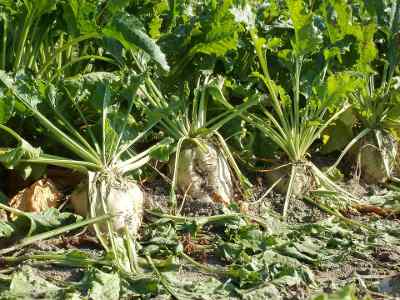Survival Garden - How To Grow Sugar Beets

Sugar beets are typically only grown for sugar production and cattle feed, not for human consumption. But the tops, the greens are edible and could be harvested as such.
Cool weather increases the sugar content of the roots. Areas with no real winter weather will be less effective but still able to grow sugar beets for sugar production.
The best daytime temperature for sugar beets is between 60F to 80F for the first 90 days of plant growth.
Best planting dates in Wisconsin are from late April 20 to early May, in Louisiana. plant in February or August through Early October.
To grow sugar beets pick a spot free of trees. Till the soil and add with compost to increase organic matter in the soil.
Broadcast seed at a rate of 8 to 10 lbs per acre. The seed should be spread over a worked seed bed without other vegetation present. Do not mix sugar beets with other crops. Sugar beets just don't do well against other competition. Once broadcast the seed should be worked into the soil by dragging something like a small log over the top of the dirt.
After the sugar beets have begun to grow you will probably need to thin them out a bit. Sugar beets get quite large and need their space. Overcrowding will actually lower yields.
Be careful to not cover the seed with more than a 1/4 inch of dirt. Sugar beet seed is small. If you plant too deep the seed will run out of energy and die before it can reach the surface and put out leaves.
Sugar beets can then be pretty much left on their own. Watering may be needed if rainfall doesn't occur for long periods of time. All plants need water! Irrigation or watering is needed in dry climates and row elevation is needed in wet areas that occasionally hold water.
The only other thing to do is to keep the weeds under control. The less weed competition the better that is for the sugar beets. Mulch is a great way to help prevent weeds as well as a great way to keep the soil moisture up. Allow 80 to 90 days after emergence before harvesting you sugar beets for consumption.
Early in the spring of the second year sugar beets will become ready for harvest. You will want to gather seeds for replanting, so don't harvest all of your beets. Leave a small portion of your plants untouched, and let them flower.
Saving seed has its difficulties. You must keep the plants alive throughout the winter. In climates that get really cold you will have to dig up the plants and store them in a safe place to protect them from the cold.
Dig up the sugar beet plants in the fall after their tops have begun to yellow and fall over. Dig the whole plant up, gently.
Fill a container with moist sand. Cut off the tops off the beet roots and then bury the roots in the sand so they aren't touching each other. Place the container somewhere that gets cool, yet is protected from freezing.
In warmer climates that do not experience harsh winters the sugar beets can be left in the ground and simply mulched to protect them from the cold.
Replant the sugar beets in the spring.
Water the beets as needed to keep the soil moist until they produce flowers in summer. Cut off the flowers when they are dry. Rub the flowers to separate the flower and stem from the seed. Separate the seed and discard the rest.
Place the seeds sealed container. Store the container in a cool dark place.
Be sure not to use F1 seeds. These are commonly used hybrids that you can not use to produce more seeds because the seeds will not be pollinated.
Back to Survival Garden
